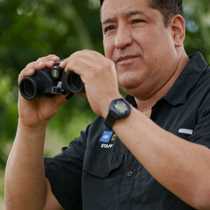Yanayacu & Pucate Rivers
I woke up this morning feeling that today was going to be a great day. I was not wrong for we had a wonderful beginning of our expedition around the Pacaya-Samiria Reserve. Very early in the morning we went to explore one of the hundreds of tributaries of the Marañon River, the Yanayacu River. Once on the skiffs we spotted several Amazon beautiful bird species like Oriole Blackbirds, Yellow-hooded Blackbirds, and several parrot species among others. Later in the morning, after a succulent breakfast, we went back again to the Yanayacu River, but this time we went to explore some of the many smaller black water creeks that are found along the river.
With amazement we experienced not only the view of many bird species but truly enjoyed being surrounded by giant walls of tropical vegetation. One bird species in particular, due to its beauty, captured the attention of their observers, the Capped Heron (Pilherodius pileatus). This bird is one of the most visually striking heron species in the world. It is cream colored, has a blue face and base to bill and a conspicuous black cap.
In the afternoon we once again boarded our fleet of skiffs with high hopes. We explored the Pucate River. During this skiff ride we had a sighting that is for its rarity one to be remembered for a long time. We saw the mighty Harpy Eagle! (Harpia harpija). Just in the morning in my introductory talk to the Amazon I mentioned about this gargantuan bird of prey. I was asked about the odds to see one these mythical birds in the wild. I mentioned that the last one I saw was back in 1994 on an expedition on the Cuyabeno Reserve in Ecuador. I mentioned as well that as we are in the Amazon the possibilities are there and wow! We saw a harpy eagle today in the morning.
This event is so rare that is was the first time in ten years for Adonai Rodriguez, one of our local Peruvian Naturalists that was in our skiff. Adonai was born in the area and has spent most of his life around the Pacaya-Samiria Reserve. This extraordinary sighting took us by surprise. Adonai shouted to attract our attention for a big animal was being chased by a couple of Yellow-headed caracaras. Adonai then shouted “It is a Harpy Eagle, harpy eagle!” and then my heart started pounding at a fast rhythm. I had my camera in hand but I was not able to take a picture in the midair while the birds were crossing the river. With a little luck the bird landed in a nearby palm tree.
The harpy eagle is considered the most powerful animal in the air in the Amazon. It is comparable to seeing a jaguar in land or an anaconda in the water, therefore the sighting we had today is a memorable one. The harpy eagle is a huge bird of prey, in fact is the largest and bulkiest bird of Peru. It can easily reach 35 to 40 inches in length from the tip of the bill to the tip of its bill. The wingspan is 69 to 79 inches. The harpy eagle rarely is seen soaring for it hunts very quietly within the vegetation waiting for perching in the canopy to capture large mammal prey. Their talons, tarsi and toes are so powerful that can easily lift a Brown-throated three-toed sloth or very large and heavy monkeys like the red howlers.
I felt a lot emotions while watching through my camera the characteristic bifurcated crest trademark of this powerful bird. I know many people that have been coming for years to the Amazon with the hope to see a Harpy Eagle in the wild. Today we have this rare privilege!




